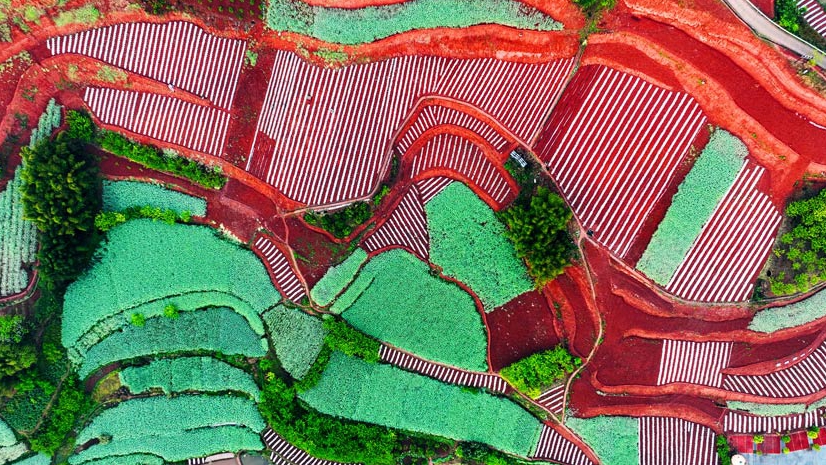China promotes conservation, utilization of Globally Important Agricultural Heritage Systems
In recent years, China has advanced the conservation of important agricultural heritage sites, while various localities around the country have strived to push forward rural vitalization in a comprehensive way through the application of agricultural heritage.

Photo taken on July 18, 2022 shows fish swimming in a protection area of the rice-fish co-culture system in Qingtian county, east China's Zhejiang Province. (Photo/Xinhua)
Qingtian county in east China's Zhejiang Province is famous for its symbiotic rice-fish co-culture system, which has a history of more than 1,000 years.
Early in 2005, the traditional rice-fish co-culture system in Qingtian was listed in the world's first group of Globally Important Agricultural Heritage Systems (GIAHS) designated by the Food and Agriculture Organization (FAO) of the United Nations, becoming the first GIAHS in China. So far, the rice-fish co-culture system has been promoted in over 20 provincial-level regions across the country.
China has recognized 138 important agricultural heritage sites in 29 provincial-level regions, according to Hou Yaoyu, an official with the country's Ministry of Agriculture and Rural Affairs (MARA).
In May this year, the FAO designated three more sites in China as GIAHS, bringing the total number of GIAHS in the country to 18, the highest in the world, introduced Sui Pengfei, director general of MARA’s international cooperation department. The three new sites include an ancient tea-producing area in Anxi county of east China’s Fujian Province, a nomadic livestock-rearing region in Chifeng city of north China’s Inner Mongolia Autonomous Region, and a rain-fed stone terrace farming system in Shexian county of north China’s Hebei Province.
These 18 GIAHS in China cover agriculture, forestry, animal husbandry and fisheries, as well as mountain, river, forest, farmland, lake, grassland and desert ecosystems, contributing Chinese wisdom to the identification, conservation and utilization of agricultural heritage systems in the world, said Sun Yehong, a professor at the Tourism College of Beijing Union University.
Suiting agricultural activities to local conditions is an important guideline for the sustainable development of agricultural heritage sites, said Bai Yun, a member of the expert committee for GIAHS under the MARA.
Marked by spectacular terraces that cascade down the slopes of mountains to rivers, the Shangbao rice terraces, a GIAHS site in Chongyi county of east China's Jiangxi Province, have been cultivated for over 800 years.

In this aerial photo, villagers celebrate in traditional costumes as they start ploughing and release fish fry into rice fields in Xiaozhoushan Township, Qingtian county, east China's Zhejiang Province, June 11, 2020. (Photo/Xinhua)
The Shangbao rice terraces feature a sound ecosystem consisting of bamboo forests, villages, terraced fields and rivers, introduced Lu Xinping, director of the bureau of water resources of Chongyi county.
Lu explained that the bamboo forests high on the slopes are vital for water conservation, while the terraces are built according to the gradients of the slopes with a maximum vertical drop of about 1,000 meters. River water evaporates to form clouds, which then gathers together to produce a mist of rain for natural irrigation.
Agricultural heritage sites reflect the ecological philosophy of respecting nature, following nature's law and pursuing harmony between man and nature, said Tang Zhiqiang, director of the agricultural history and research department of the China Agricultural Museum. According to Tang, agricultural heritage sites promote sustainable agricultural development and maintain biodiversity.
The green and efficient agricultural development models, including intercropping and a combined method of farming and husbandry, are still applied to agricultural heritage sites, said Li Xiande, vice chairman of the expert committee for GIAHS under the MARA. This provides useful lessons for the green development of the agricultural sector, Li added.
While preserving agricultural heritage sites, efforts should be made to sustainably utilize these sites that feature sound ecological environments, rich folk cultures and beautiful rural landscapes, Bai said.
In addition to enhancing the conservation of agricultural heritage sites, multiple localities in China have explored these sites' potential in germplasm resources, cultural inheritance and tourism, among other areas, lending new impetus to rural vitalization.
The brand value of agricultural products produced at the GIAHS localities has risen by 10 percent to 30 percent, and GIAHS conservation and utilization contribute to around 40 percent of local residents' direct income, according to a research report issued by the Center of International Cooperation Service under the MARA.
Li pointed out that China needs to add new dimensions to agricultural heritage sites by building agricultural and cultural brands, boosting the development of efficient eco-agriculture, rural tourism, and cultural and creative industries, so as to help farmers at agricultural heritage sites continuously increase their incomes.
Photos
Copyright © 2022 People's Daily Online. All Rights Reserved.









